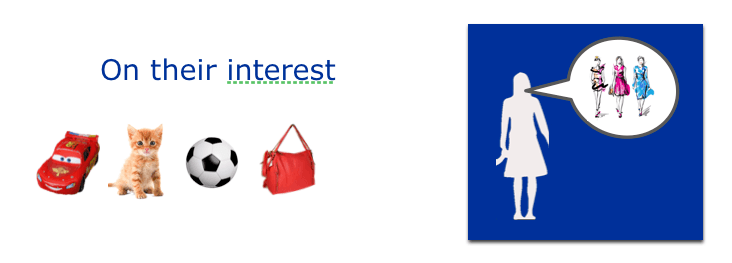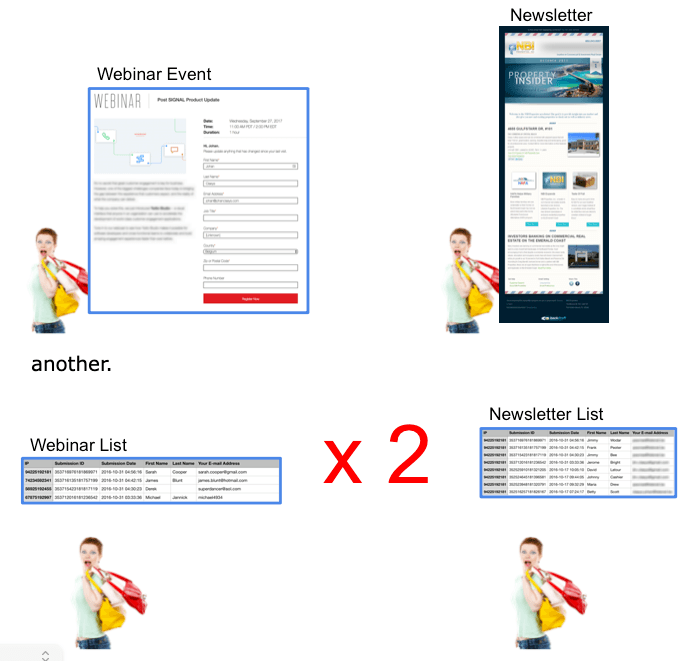How to segment your email contacts list
Segmenting in email marketing is all about the process of defining and subdividing your subscribers into clearly identifiable segments with similar needs, wants or demand characteristics. The process of getting to know your subscribers, so that you can make informed decisions on who, how and when to send emails
Tip: How to segment your email contacts list - is also available as an ebook (pdf) for offline reading.
What is segmenting?
In this post, I would discuss why segmenting your contacts is important to improving your target marketing efforts, as well as the personalisation of your email messages to your Contacts.
I am also going to show you how segmentation can help you achieve your goals, and greatly improve your email marketing campaigns.
Are you ready to learn how? Then, let us proceed.
It’s about knowing your contacts

Let’s start by learning what segmentation means. You see, most businesses have more than one kind of customer, and more than one type of product or service.
In addition, contacts will be in different stages of their interaction with your business, and not everyone may be interested in the same thing.
Not everyone has the same interests!
If you send identical emails to everyone, some of your contacts may find your message inappropriate for them. They may delete the email, and possibly unsubscribe
or even report you as a spammer!
To illustrate, the boy in the picture likes matchbox cars, the woman is a fashionista, the husband’s hobby is soccer, and the little girl loves cats.
So you need to know your customer
What do you need to know
It’s really all about knowing your customers, and you can achieve this through segmentation of your data. You can start with the basics in the segmentation process.
Age and Gender
Know the age and gender of your customers to send targeted messages to.
Demographics, Geographics, Behavioral, tags
It becomes much more interesting when you can send targeted messages to contacts or groups of contacts based on what you know about them, including demographics, location, behaviors, tags.

demographics

geographics

behavior

Tags
Content based on interests
And much more effective it can become when you can start send targeted messages or content to contacts or groups of contacts based on what is really on their interest.

Content based on what they really want
And, it becomes even more powerful when you can send targeted messages or content to contacts or groups of contacts based on what they really want !!!

List Centric vs Contact Centric

Difference is important to know
Before I begin, I need to go over the differences between the two main types of email management applications - list-centric- and -contact-centric. In a different ebook I covered these, but I need to go over them again because it is in segmentation that their differences really become crucial.
Contact-centric email service providers rely on tags rather than lists. Instead of a person ending up on two or more lists, they can be on only one list, and are simply given two or more tags.
Not all systems allow good segmentation
Not all systems allow good segmentation, however. It usually starts out as an easy process, but challenges may arise when the email system that you have chosen is self-limiting.

Spreadsheet systems are clunky
When you work with Spreadsheet-based systems, you will find that they work fine when they remain static. However, when you start to add extra columns and try to sort and extract a subset, things tend to get messy.

Home-made interactive databases?
So, why work with static spreadsheets? For one, it allows you to design your own interactive database, but then again, why go to that extent when you have a true email service provider like MailChimp, which is free for the first 2,000 contacts?


MailChimp is List-centric
Another way to look at segments

Let’s start the discussion with MailChimp, which is massively popular today. MailChimp works via Lists; thus, it is considered as list-centric. Subscribers to your opt-in forms are sent directly to a list - a single list.
If they subscribe to some of your other offers, they will be sent to a different list. Each of the lists has its own form fields. You can even copy and move your subscribers over from one list to another.

In MailChimp, these different lists are called segments.
List-centric
When you want to do a mail campaign, you need to choose the list, and you send the mail to everyone on the list. If you mail to two lists, you risk mailing a specific person twice! Also, the data relating to your contact may be spread across both lists, exposing you to possible errors and omissions.
Let’s cite an example: different data stored for similar field headers in two separate lists for the same contact. In order to remediate, you should start to export and manually merge the data of your contacts.
How about Contact-Centric?
Only One List
A more useful option is to have a contact-centric system where all data about a contact is held in one place, and there is no risk of duplication of data.
The lists may still offer broad segmentation of your contacts, but each contact is only flagged as existing on a list without the email details actually being duplicated.

Lists, tags and custom fields
The three properties : 1. Lists

The best way to manage your contacts is to maintain only one list, but if it is necessary to maintain more, then each list should be mutually exclusive. For example, Lead and Customer lists.
The three properties : 2. Tags
You will then be able to use tags to further classify your data. Tags represent a condition or a set of conditions that are often not permanent. They can easily be applied or removed. “Remember the favorite red colour” Tags are not an option in a list-centric application.

The three properties : 3. Custom Fields
Custom fields are added for data that is either permanent or unlikely to change often.

So, to recap
In a contact centric system, you have one list, although you can have mutually exclusive list displays. Tags offer a way to label or better classify your contacts based on temporary properties you have gathered. Custom fields are filled with data that is either permanent or unlikely to change often.

In a contact centric system, you are able to segment your one list based on these three properties: exclusive list displays, temporary properties and permanent data about your contacts.

Segmenting versus segments
Making informed decisions
When your contact data is well-organised, you can make informed decisions on how to send them mails. You will be able to extract a segment that matches your offer. Take the example of the red handbag. If your contact data has been stored effectively, and you are selling a red handbag, you will be able to identify the women who are interested in fashion (fashionistas), and have the “favorite red color” tag. You may then send mails only to them.
Extracting a segment
So, when planning a mail campaign - or broadcast - you extract a segment of your contacts that fit your campaign objectives, which, in this case, is to get someone to buy your red handbags.

You can do this ‘on-the-fly’ just at the point of mailing, or you can save this segment as a broadcast-list to use again in a later campaign.
Don’t get confused
Don’t get confused between your permanent Contact Lists, and these temporary broadcast-lists, which are simply a subset of your data.

Let’s get back to the main topic of this ebook, and the process that you need to think about when collecting and segmenting information about your contact.
Attributes and Actions
A key concept when ‘tagging’ your contacts is attributes and actions.
An attribute is a feature or quality that you have learned about your contact. An action is the behavior that your contact displays when interacting with your emails or online pages.

If you follow the actions of your contacts, you are listening not only to what they want, but also to what they do.
It is all about personalisation

Segmentation on the fly allows your campaigns to improve personalisation.
The better you get at this, the better the personalisation of your broadcast mailings, and the more likely your contact will open the email, and further click on the links you have strategically added.
Your email reputation will improve as fewer of your emails will be flagged as spam.
Learn about segmenting - The Process Of Getting To Know Your Subscribers - So That You Can Make Informed Decisions On Who, How And When To Send Emails To #intelliweb
Subdividing on form submits
Segmenting on form submits
Your segmentation can start as soon as your contact opts in by submitting a form or light box on a landing page. For example:
You can, however, exercise your creativity and use multiple choice opt-in forms, results-oriented quizzes, product offer & sales pages, training courses, and event marketing.
In the email marketing platform, set up a rule. Depending on the form they opted in, they get automatically added to a new segment by attributing a tag.

These opt-ins are a great way to initiate a sequence of auto responder emails. I will not go into details now because I will cover this in another ebook.
Segmenting at point of contact via email
Your segmenting can also start at the first point of contact through email, by getting your subscriber to take action and being added to a new segment by attributing a tag, according the choice ticked.
For example, if your site focuses on digital marketing, you can ask your subscribers to click. For example, one of the four topics they’re most interested in receiving, which is related to digital marketing.

Again, in your email marketing platform, you set up a rule so that depending on the link a subscriber clicks in the email, they are instantly included in a new segment.
For example, if they click on the option ‘Landing pages’, they can be automatically added to a list called ‘Subscribers Interested in Landing Pages.
In the future, if you plan to send a sales mail about ‘Landing Pages’, you can send it only to that list, instead of the general list containing all your readers.
This keeps the message you send out interesting for the different subscriber types. This way, they keep opening and reading your messages in the future. This gives you more chances to gain their trust for your products.
Choosing the right platform
It must be right for you
ConvertKit versus ActiveCampaign
I am an affiliate of ConvertKit and ActiveCampaign, so I am fully disclosing that here.


Both have segments, tags and custom fields for you to segment your contacts with precision and efficiency. They are both top-end systems, but serve slightly different markets.
ActiveCampaign is very strong and flexible in building complex automations, and I love it, and would recommend it to anyone who needs such functionality. However, it is not nearly as comfortable as ConvertKit when it comes to managing sequences of emails where your focus is on actively customising and improving the wording and links of the individual emails.
Conclusion
Email database segmentation is not easy,…
but it is rewarding once you get it right. And when you do, you will find that email marketing can knock spots off using social media.
“Email segmentation has the greater chance to result in responsive and active contacts”
BLOG CATEGORIES
RELATED POSTS
BUILD YOUR MAILING LIST


